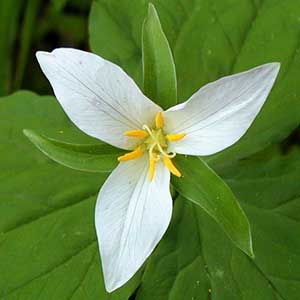Trillium ovatum
Trillium rivale
Pacific trillium, trillium, western trillium, western wake-robin, western white trillium, white or western trillium, white trillium
brook trillium, brook wake-robin
semierect to horizontal, short, stout, praemorse.
horizontal, short, praemorse, fleshy.
1–2, round, 2–5 dm, ± slender, glabrous.
1–2, round in cross section, 0.4–1.5 dm, slender, glabrous.
sessile, subsessile, or short-petiolate;
blade medium green, sometimes blotched and mottled, main veins prominent, ovate-rhombic, 7–12 × 5–20 cm, continuing to expand during anthesis, base rounded, apex acuminate.
distinctly petiolate;
blade bluish green, occasionally with silvery green pattern along major veins, ovate-lanceolate, 1.5–8 × 0.8–6 cm, somewhat thick-textured, glossy, weakly to strongly cordate basally, apex long-acuminate;
petiole (0.5–)1–3(–6) cm.
erect or nodding, odorless;
sepals spreading to horizontal, green, lanceolate to oblong-lanceolate, 15–50 × 6–20 mm, margins entire, apex acute;
petals erect-ascending, usually wide-spreading from base, exposing entire pistil, white or with pink or blush markings, lacking V-shaped markings, fading to rosy pink, purple, or dark red, veins not deeply engraved, ± linear to widely obovate, 1.5–7 ×1–4 cm, widest at or above middle, thin-textured, margins flat to undulate, apex acuminate;
stamens prominent, slightly recurved-spreading to straight, 10–18 mm;
filaments white, shorter than anthers, slender;
anthers yellow, 4–16 mm, slender, dehiscence latrorse-introrse;
ovary green or white, ovoid, 6-angled, 5–12 mm, attachment ± 3/4 ovary width;
stigmas recurved, barely connate basally, greenish white or white, linear, not lobed adaxially, 6–10 mm, uniformly thin;
pedicel erect to leaning, 2–6 cm.
erect, rapidly recurving below bracts after pollination, ± odorless;
sepals conspicuous, spreading, green, weakly sulcate, oblong or tapered apically, usually shorter and narrower than petals, 10–23 × 4–8 mm, margins entire, apex rounded-apiculate;
petals erect-spreading, not recurved or only in distal 1/2, white (rarely pale pink), usually with dark madder-purple flecks, rarely almost entirely covered with madder-purple, color not changing with age, veins inconspicuous, not engraved, ovate-cordate to ± orbicular, tapered bluntly apically above middle, 1.3–2.8 × 1–2.4 cm, ± thin-textured, base rounded, cuneate, margins entire, mostly without undulations, apex ± apiculate-acuminate;
stamens erect, 5–12 mm;
filaments white, ± equaling anthers;
anthers straight, yellow, 3–6 mm, dehiscence ± extrorse;
connectives not extended beyond anther sacs;
ovary creamy white, ovoid, weakly 6-angled but angles in close pairs, giving superficial impression of 3-angled ovary, short, 3–9 × 4 mm, somewhat obscured by anthers broadly attached;
stigmas recurved and appearing ± lobed adaxially, at least in dried specimens, connate basally to distinct and closely grouped, white or cream, 2–4 mm, uniformly thick, fleshy;
pedicel strongly erect at anthesis, strongly recurving and elongating below bracts after pollination, 2.5–11 cm.
baccate, green or white, ± odorless, broadly ovoid, obscurely winged, 1.2–2.8 × 0.7–1.9 cm, pulpy-moist.
greenish white, odorless, globose, 0.9–1.2 × 0.8–1 cm, pulpy, not juicy.
= 10.
= 10.
Trillium ovatum
Trillium rivale
Varieties 2 (2 in the flora).
(Discussion copyrighted by Flora of North America; reprinted with permission.)
Trillium rivale is confined to the Klamath and Siskiyou mountains of southwestern Oregon and California. It has a strong affinity for banks along streams and adjacent to trickles in Darlingtonia bogs, mainly on serpentine soils. After flowering, the entire plant may enlarge and become more robust and turgid with very glossy leaves.
(Discussion copyrighted by Flora of North America; reprinted with permission.)
1. Bracts sessile; petals lanceolate to obovate, 1.5–7 × 1–4 cm | var. ovatum |
1. Bracts distinctly short-petiolate; petals linear to linear-lanceolate, 0.5–2.4 × 0.2–0.6 cm | var. oettingeri |
- Local floras:
BC,
CA,
OR,
WA
- Local Web sites:
CalFlora,
CalPhotos,
Flora NW,
PNW Herbaria,
Turner Photog.
WildflowerSearch
iNaturalist (observations)
USDA Plants Database
- LBJ Wildflower Center
- SEINet
- Plants of the World Online
- Encyclopedia of Life
- Wikipedia
- Google Image Search


